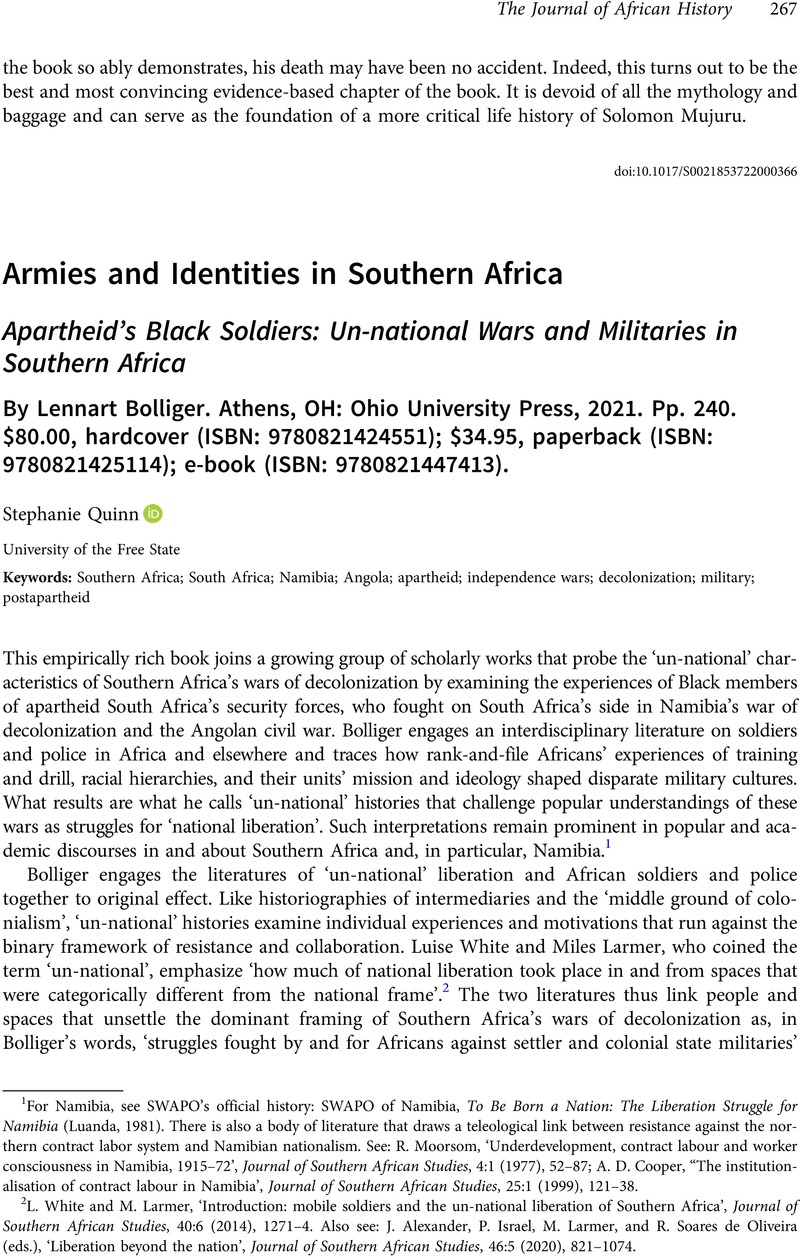No CrossRef data available.
Article contents
Armies and Identities in Southern Africa - Apartheid's Black Soldiers: Un-national Wars and Militaries in Southern Africa By Lennart Bolliger. Athens, OH: Ohio University Press, 2021. Pp. 240. $80.00, hardcover (ISBN: 9780821424551); $34.95, paperback (ISBN: 9780821425114); e-book (ISBN: 9780821447413).
Review products
Published online by Cambridge University Press: 23 September 2022
Abstract

Keywords
- Type
- Book Review
- Information
- Copyright
- Copyright © The Author(s), 2022. Published by Cambridge University Press
References
1 For Namibia, see SWAPO's official history: SWAPO of Namibia, To Be Born a Nation: The Liberation Struggle for Namibia (Luanda, 1981)Google Scholar. There is also a body of literature that draws a teleological link between resistance against the northern contract labor system and Namibian nationalism. See: Moorsom, R., ‘Underdevelopment, contract labour and worker consciousness in Namibia, 1915–72’, Journal of Southern African Studies, 4:1 (1977), 52–87CrossRefGoogle Scholar; Cooper, A. D., “The institutionalisation of contract labour in Namibia’, Journal of Southern African Studies, 25:1 (1999), 121–38CrossRefGoogle Scholar.
2 White, L. and Larmer, M., ‘Introduction: mobile soldiers and the un-national liberation of Southern Africa’, Journal of Southern African Studies, 40:6 (2014), 1271–4CrossRefGoogle Scholar. Also see: Alexander, J., Israel, P., Larmer, M., and de Oliveira, R. Soares (eds.), ‘Liberation beyond the nation’, Journal of Southern African Studies, 46:5 (2020), 821–1074CrossRefGoogle Scholar.
3 White and Larmer, ‘Introduction’.
4 M. Moyd, Violent Intermediaries: African Soldiers, Conquest, and Everyday Colonialism in German East Africa (Athens, OH, 2014). See also G. Mann, Native Sons: West African Veterans and France in the Twentieth Century (Durham, NC, 2006).
5 C. A. Williams, National Liberation in Post-Colonial Southern Africa: A Historical Ethnography of SWAPO's Exile Camps (Cambridge, 2015).
6 D. Henrichsen, G. Miescher, C. Rassool, and L. Rizzo (eds.), ‘The South African Empire’, Journal of Southern African Studies, 41:3 (2015), 431–685; S. Quinn, ‘Scalar claims, worker strategies, and “South Africa's labour empire” in Namibia, 1943–1979’, Journal of Southern African Studies, 47: 1 (2020), 57–78; J. Crush, A. Jeeves, and D. Yudelman, South Africa's Labour Empire: A History of Black Migrancy to the Gold Mines (Boulder, 1991).
7 Bolliger cites literatures on transnational conflicts in East and Central Africa, but as histories of African soldiers rather than transnational or un-national histories. For example: Larmer, M., ‘Of local identities and transnational conflict: the Katangese gendarmes and Central-Southern Africa's forty years war, 1960–99’, in Arielli, N. and Collins, B. (eds.), Transnational Soldiers: Foreign Military Enlistment in the Modern Era (New York, 2013)Google Scholar; Branch, D., Defeating Mau Mau, Creating Kenya: Counterinsurgency, Civil War, and Decolonization (Cambridge, 2009)Google Scholar.
8 The ‘middle ground’ idea comes from Richard White and, later, Luise White. White, R., The Middle Ground: Indians, Empires, and Republics in the Great Lakes Region, 1650–1815 (Cambridge, 1991)Google Scholar; White, L., ‘Students, ZAPU, and Special Branch in Francistown, 1964–1972’, Journal of Southern African Studies, 40:6 (2014)CrossRefGoogle Scholar.





